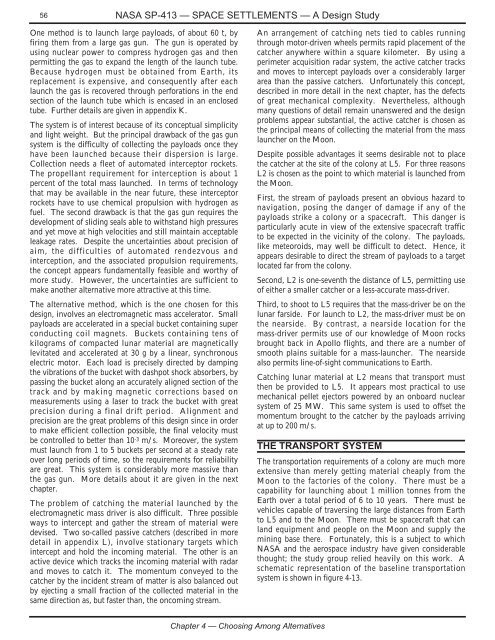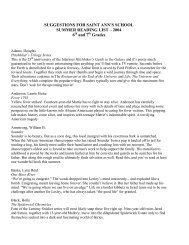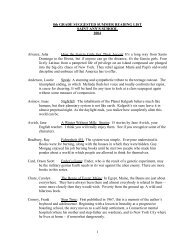NASA SP-413 Space Settlements - Saint Ann's School
NASA SP-413 Space Settlements - Saint Ann's School
NASA SP-413 Space Settlements - Saint Ann's School
You also want an ePaper? Increase the reach of your titles
YUMPU automatically turns print PDFs into web optimized ePapers that Google loves.
56<br />
<strong>NASA</strong> <strong>SP</strong>-<strong>413</strong> — <strong>SP</strong>ACE SETTLEMENTS — A Design Study<br />
One method is to launch large payloads, of about 60 t, by<br />
firing them from a large gas gun. The gun is operated by<br />
using nuclear power to compress hydrogen gas and then<br />
permitting the gas to expand the length of the launch tube.<br />
Because hydrogen must be obtained from Earth, its<br />
replacement is expensive, and consequently after each<br />
launch the gas is recovered through perforations in the end<br />
section of the launch tube which is encased in an enclosed<br />
tube. Further details are given in appendix K.<br />
The system is of interest because of its conceptual simplicity<br />
and light weight. But the principal drawback of the gas gun<br />
system is the difficulty of collecting the payloads once they<br />
have been launched because their dispersion is large.<br />
Collection needs a fleet of automated interceptor rockets.<br />
The propellant requirement for interception is about 1<br />
percent of the total mass launched. In terms of technology<br />
that may be available in the near future, these interceptor<br />
rockets have to use chemical propulsion with hydrogen as<br />
fuel. The second drawback is that the gas gun requires the<br />
development of sliding seals able to withstand high pressures<br />
and yet move at high velocities and still maintain acceptable<br />
leakage rates. Despite the uncertainties about precision of<br />
aim, the difficulties of automated rendezvous and<br />
interception, and the associated propulsion requirements,<br />
the concept appears fundamentally feasible and worthy of<br />
more study. However, the uncertainties are sufficient to<br />
make another alternative more attractive at this time.<br />
The alternative method, which is the one chosen for this<br />
design, involves an electromagnetic mass accelerator. Small<br />
payloads are accelerated in a special bucket containing super<br />
conducting coil magnets. Buckets containing tens of<br />
kilograms of compacted lunar material are magnetically<br />
levitated and accelerated at 30 g by a linear, synchronous<br />
electric motor. Each load is precisely directed by damping<br />
the vibrations of the bucket with dashpot shock absorbers, by<br />
passing the bucket along an accurately aligned section of the<br />
track and by making magnetic corrections based on<br />
measurements using a laser to track the bucket with great<br />
precision during a final drift period. Alignment and<br />
precision are the great problems of this design since in order<br />
to make efficient collection possible, the final velocity must<br />
be controlled to better than 10 -3 m/s. Moreover, the system<br />
must launch from 1 to 5 buckets per second at a steady rate<br />
over long periods of time, so the requirements for reliability<br />
are great. This system is considerably more massive than<br />
the gas gun. More details about it are given in the next<br />
chapter.<br />
The problem of catching the material launched by the<br />
electromagnetic mass driver is also difficult. Three possible<br />
ways to intercept and gather the stream of material were<br />
devised. Two so-called passive catchers (described in more<br />
detail in appendix L), involve stationary targets which<br />
intercept and hold the incoming material. The other is an<br />
active device which tracks the incoming material with radar<br />
and moves to catch it. The momentum conveyed to the<br />
catcher by the incident stream of matter is also balanced out<br />
by ejecting a small fraction of the collected material in the<br />
same direction as, but faster than, the oncoming stream.<br />
An arrangement of catching nets tied to cables running<br />
through motor-driven wheels permits rapid placement of the<br />
catcher anywhere within a square kilometer. By using a<br />
perimeter acquisition radar system, the active catcher tracks<br />
and moves to intercept payloads over a considerably larger<br />
area than the passive catchers. Unfortunately this concept,<br />
described in more detail in the next chapter, has the defects<br />
of great mechanical complexity. Nevertheless, although<br />
many questions of detail remain unanswered and the design<br />
problems appear substantial, the active catcher is chosen as<br />
the principal means of collecting the material from the mass<br />
launcher on the Moon.<br />
Despite possible advantages it seems desirable not to place<br />
the catcher at the site of the colony at L5. For three reasons<br />
L2 is chosen as the point to which material is launched from<br />
the Moon.<br />
First, the stream of payloads present an obvious hazard to<br />
navigation, posing the danger of damage if any of the<br />
payloads strike a colony or a spacecraft. This danger is<br />
particularly acute in view of the extensive spacecraft traffic<br />
to be expected in the vicinity of the colony. The payloads,<br />
like meteoroids, may well be difficult to detect. Hence, it<br />
appears desirable to direct the stream of payloads to a target<br />
located far from the colony.<br />
Second, L2 is one-seventh the distance of L5, permitting use<br />
of either a smaller catcher or a less-accurate mass-driver.<br />
Third, to shoot to L5 requires that the mass-driver be on the<br />
lunar farside. For launch to L2, the mass-driver must be on<br />
the nearside. By contrast, a nearside location for the<br />
mass-driver permits use of our knowledge of Moon rocks<br />
brought back in Apollo flights, and there are a number of<br />
smooth plains suitable for a mass-launcher. The nearside<br />
also permits line-of-sight communications to Earth.<br />
Catching lunar material at L2 means that transport must<br />
then be provided to L5. It appears most practical to use<br />
mechanical pellet ejectors powered by an onboard nuclear<br />
system of 25 MW. This same system is used to offset the<br />
momentum brought to the catcher by the payloads arriving<br />
at up to 200 m/s.<br />
THE TRAN<strong>SP</strong>ORT SYSTEM<br />
The transportation requirements of a colony are much more<br />
extensive than merely getting material cheaply from the<br />
Moon to the factories of the colony. There must be a<br />
capability for launching about 1 million tonnes from the<br />
Earth over a total period of 6 to 10 years. There must be<br />
vehicles capable of traversing the large distances from Earth<br />
to L5 and to the Moon. There must be spacecraft that can<br />
land equipment and people on the Moon and supply the<br />
mining base there. Fortunately, this is a subject to which<br />
<strong>NASA</strong> and the aerospace industry have given considerable<br />
thought; the study group relied heavily on this work. A<br />
schematic representation of the baseline transportation<br />
system is shown in figure 4-13.<br />
Chapter 4 — Choosing Among Alternatives
















